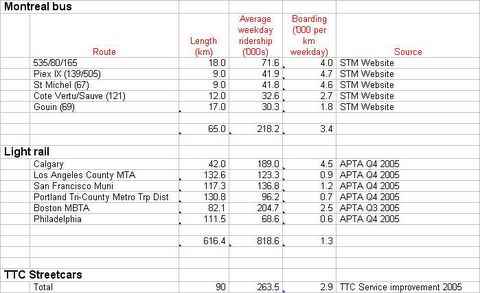Steve Munro was kind enough to comment on this blog's recent commentary on a post in his blog. Writes Steve:
The last time I went to the Gladstone, I waited for the Dufferin Bus southbound at Bloor for 20 minutes in the afternoon rush hour. Eventually, I got a ride from a friend who passed by in her car. So much for the reliability of bus service.J. Albert - I'll agree that schedule reliability is low on the TTC. Both Bus and streetcar languish in the 55-65% range last time I checked the CGM reports. In contrast, the STM (Montreal's transit provider) achieves roughly 80% adherence - with performance improving from 78.9% in 2001 to 82.6% in 2004.
(It should be noted that the STM uses a tighter tolerance: -1 min, + 3 min, compared with the +/- 3 minutes used for the TTC metrics.)However, there is a distinction between TTC bus and streetcar service. The TTC actually tries to alleviate bunching problems by short turning cars. It's questionable whether - on the whole - this practice improves the service offering. You can just as easily customers by booting them off a vehicle as you can by making them wait. Yet the short turn is the only real tool the TTC has for adjusting service on streetcar routes.
Bus service can be more easily adjusted by allowing buses on busy routes to play 'hopscoth'. The STM has done this for years - allowing emptier buses to pass full ones on the same route. I've never seen this on the TTC - not to say that it doesn't happen.
It would be interesting to see statistics on more extreme deviations from schedule. How many times is it out by 5, 7, 10 minutes?
The problem with a lot of the streetcar service is that there isn't enough of it and what there is is poorly managed. Moreover, the streetcar routes took a disproportionate hit back in the 1990s during the system-wide cutbacks, and it's no surprise that people think bus routes are more reliable.J. Albert - As a rider, I can't say that I wouldn't like more service. However, it seems to me that the economics dictate against a 'frequent service' model for streetcar/LRT service - both immediately, and long term. There's some debate about how much true spare factor the TTC has with the existing fleet. During PM rush, the streetcar yards on Queen E. are pretty sparse - but the garage is usually pretty full. Is the TTC holding back - or is it simply the case that the vehicles are in the shop?
In the longer term, the price tab for CLRV replacement appears to be about $4 million a pop ($3 million from earlier estimate + $1 million estimated for TTC required modifications. In contrast, the STM is acquiring buses (2003-2007 contract) at about $460,000 each. Like it or not, buses are mass produced and inexpensive - especially when very large orders are placed - wheras LRT vehicles are not.
When the TTC replaces streetcars with buses, there are always far more buses at closer headways than the streetcars they replaced. This is related to my concern about new larger streetcars where we may see headways stretched even further. It's the wait and the uncertainty that drives riders mad, and you can do that with buses as easily as with streetcars.J. Albert - As I alluded to above, its plain economics that will push the TTC to longer headways with larger vehicles. My take is that the TTC should:- decide which existing streetcar routes can be succesfully transitioned to be LRT routes
- this would involve realignment and lengthening of some routes and conversion to buses for others.
Perhaps the TTC could swap some of its property to help make property acquisition more economical.
- an important objective of the realignment would be to allow the TTC to run standard LRT cars without major modifications. (The savings here would also provide a source of funding to pay for property aquisition.)





